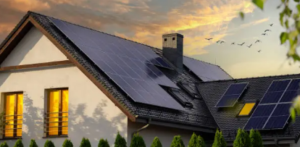Solar energy is a clean and renewable source that offers several advantages over fossil fuels. Installing Tindo Adelaide solar panels on your rooftop can reduce electric bills while protecting the environment by decreasing greenhouse gas emissions, air pollution, and water withdrawal.
 Sunlight strikes solar cells and loosens electrons from silicon atoms, producing direct current (DC). An inverter converts this DC into alternating current (AC), powering appliances and lighting your home.
Sunlight strikes solar cells and loosens electrons from silicon atoms, producing direct current (DC). An inverter converts this DC into alternating current (AC), powering appliances and lighting your home.
Solar panels
Tindo Adelaide solar panels serve a crucial purpose: turning sunlight into electricity through what’s known as the photovoltaic effect. When sunlight hits solar cells, its rays penetrate them, knocking electrons out of their orbits and channelling them into an electrical current.
Solar power production thrives best under ideal conditions: sunny and warm days. However, even on cloudy or rainy days, most residential solar systems still produce clean energy, provided they maximise production by employing energy-saving appliances, shade solutions, lighting features, and smart home features.
Solar technology supports grid stability by providing energy during peak demand when large power plants have to shut down. Furthermore, renewable energies like solar can reduce greenhouse gas emissions while making our electricity system more resilient; additionally, investing more resources like these may yield long-term cost savings on energy costs.
Solar cells
Solar cells are small squares of silicon that convert sunlight into electricity. Since individual solar cells only produce a few watts, cell modules are combined to generate significantly more power.
Solar cells made today primarily utilise crystalline silicon (c-Si). Wafers of this material are cut from large ingots that take several weeks to mature in laboratories and are produced either monocrystalline or polycrystalline, depending on your preference.
Solar cells consist of layers of semiconductor material divided into n-type and p-type subgroups. When sunlight hits the cell, electrons move from one group to the other via electric current passing across its junctions; when sunlight strikes again, electrons switch back, creating a current flow in both directions across its junctions.
Photovoltaic cells
Solar cells use the photovoltaic effect to convert sunlight directly into electricity, using thin layers of semiconductor material like crystalline silicon as PV cells.
As sunlight hits a cell, it ionises its semiconductor material, causing its outer electrons to detach themselves from their bonds and flow freely into metal contacts, forming an electric current that can power devices or be fed back into a grid.
Inverters
Tindo Adelaide solar inverters convert DC power into AC energy so you can run appliances and lights from renewable-energy systems, saving money with lower utility bills. Some inverters may even help reduce costs through reduced utility fees.
Selecting an inverter that can handle peak demand is essential for off-grid applications. Compile a list of appliances and devices you wish to operate before determining their watt or kilowatt ratings; multiply these ratings by usage hours to calculate daily energy consumption in watt-hours.
Some devices, such as electric motors and televisions, draw a higher surge or starting wattage than their usual operating wattage. Make sure your inverter has an adequate peak rating.
The sun is a powerful energy source. But it takes a lot more than just solar panels to get that power into something usable. Multiple components work together to get the solar power, convert it, send it where it needs to go and monitor its health.
Solar PV (photovoltaic) is the type of solar power most commonly used at home and business, though other technologies can provide usable energy from the sun, such as solar thermal and concentrating solar-thermal systems.
The most basic solar PV system is comprised of a layer of silicon cells within a metal frame and glass casing unit. When incoming sunlight hits the silicon, it knocks electrons loose, creating electricity. The loose electrons flow through metal contacts at the top and bottom of the panel, causing a current to flow in one direction. That current is captured through wires and fed into a solar inverter, which converts it to alternating current, the type of electricity that’s used by the electric grid and household appliances. The inverter then feeds that energy into your home or business’s electrical system.

Leave a Reply